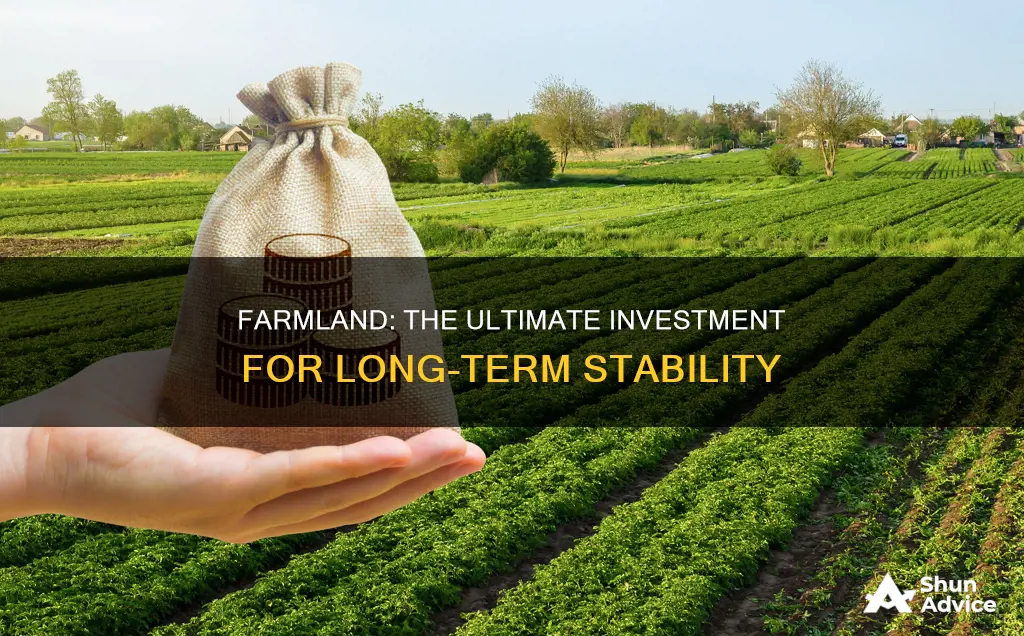
Investing in farmland is a great way to diversify your portfolio and protect your money from inflation. Farmland is a scarce commodity that steadily increases in value over time, and it's also an excellent source of passive income. In addition, the demand for farmland is only going to increase as the global population continues to rise, putting more pressure on food production. With its strong historical returns, low volatility, and hedge against inflation, farmland is an attractive investment option for those looking to add a stable asset to their portfolio.
| Characteristics | Values |
|---|---|
| Returns | Between 1992 and 2020, farmland provided average annual returns of 11%. |
| Volatility | Farmland has low volatility compared to other asset classes. |
| Inflation Hedge | Farmland is a natural hedge against inflation. |
| Passive Income | Farmland provides a source of passive income through rental and crop payments. |
| Diversification | Farmland is uncorrelated with other asset classes, providing diversification to an investment portfolio. |
| Tax Benefits | Farmland investors may be eligible for tax breaks and exemptions, such as lower property tax rates and deductions on mortgage interest. |
| Appreciation | The value of farmland tends to increase over time, providing long-term capital appreciation. |
| Stable Investment | Farmland is a stable and tangible asset that can protect your portfolio from economic volatility. |
What You'll Learn

Farmland values are rising
Farmland values have been steadily increasing over the years, and this trend is expected to continue due to several factors. Firstly, the limited supply of arable land and the increasing global demand for food. According to National Geographic Magazine, the world will require approximately double the amount of crops by 2050 to meet the needs of a growing population. This has resulted in a global supply-demand imbalance, driving up the value of farmland.
Additionally, the conversion of farmland for other purposes, such as multifamily development projects, further reduces the availability of arable land. At the same time, the consumption of food is increasing due to rising incomes per capita, with more people adopting diets with higher daily caloric intakes. This shift in consumption will be particularly notable in developing nations.
The value of farmland is also influenced by commodity prices and interest rates. When commodity prices rise, farmers earn more from their harvests, leading to higher returns for farmland investors. Commodity prices for agriculture are currently on the rise, driven by strong demand and supply shortages due to the post-COVID economic reopening and geopolitical conflicts.
The impact of inflation on the value of farmland cannot be overstated. As inflation increases, the value of farmland and crop prices tend to rise accordingly. This is because food constitutes a significant portion of an average household's expenses. As a result, investors view farmland as a natural hedge against inflation, similar to gold.
Regional differences in farmland values also exist due to variations in economic conditions, government policies, and local geographic factors. For example, cropland values are typically higher in the Pacific region, with California and Arizona having the highest-valued cropland in the United States as of 2020.
In summary, the combination of increasing global food demand, limited arable land, rising commodity prices, and inflationary pressures contributes to the steady rise in farmland values. This makes farmland an attractive investment option for those seeking stable, long-term growth potential in their portfolios.
Investing in People: What's the Risk?
You may want to see also

Farmland is a hedge against inflation
Farmland is a natural hedge against inflation. Similar to gold, farmland is used by many investors as a natural inflation hedge. Historically, the value of US farmland has been about 70% correlated with the CPI. This is largely because increases in crop prices drive increases in inflation, as a large proportion of an average household's income is spent on food.
Farmland investors receive two sources of returns from their investments: passive income from periodic rental and crop payments, and price appreciation when the property is sold. Higher crop prices translate to higher payments to investors, meaning that investing in farmland is a natural hedge against inflation. An added benefit to investors is that higher crop prices increase the value of the underlying land, which leads to more robust valuations when the asset is sold.
In recent weeks, commodity prices have soared, including prices for corn, soybeans and wheat. These staples are hitting their highest prices in more than six years, buoyed by strong export demand from China and dry weather. This is signalling to many investors that it's time to start preparing their investments for an inflationary environment.
The high inflation rate of 7.5% is hurting most businesses and their stock market valuations by increasing costs, decreasing profitability and expanding discount rates in valuation models. But farmland is one of the rare asset classes that actually benefit from inflation. This is because you cannot print more farmland, but its demand is always growing. Its supply is limited and even declining each year as more farmland is converted into other uses like multifamily development projects.
The global population keeps increasing, and as more people join the middle class in emerging countries, their consumption also increases. The result is that the amount of farmland per capita in the world is declining rapidly, and since it is vital to our survival, it is not surprising that its value is inflation-proof.
Is It Worth Investing in Ripple?
You may want to see also

Farmland provides attractive returns with low volatility
Returns and Volatility
Between 1992 and 2020, farmland provided average annual returns of nearly 11%, including income and price appreciation. In comparison, the stock market returned only 7.8% on average over the same time period, while gold returned around 6%.
Risk-Adjusted Returns
Farmland looks even better when considering risk-adjusted returns. During the same period, the volatility of the stock market was 16.7%, while gold was not far behind at 14.8%. The volatility of farmland was 6.8%, which is most comparable to high-quality US bonds (4.5% volatility). The Sharpe Ratio is a commonly used measure of risk-adjusted returns, with lower Sharpe Ratios corresponding to lower risk-adjusted returns. The Sharpe Ratio of farmland was 1.19, compared to 0.64 for bonds, 0.31 for US stocks, and 0.22 for gold.
Store of Value
High returns coupled with low volatility make US farmland an excellent store of value over time. If you had invested $100 in US farmland on December 31, 1991, it would be worth $1,981 on December 31, 2020 (using the NCREIF Farmland Index as a proxy)—an increase of 19.8 times. In comparison, a $100 investment in the stock market would only be worth $901 over the same time period.
Inflation Hedge
Farmland is a natural hedge against inflation. Historically, the value of US farmland has been about 70% correlated with the Consumer Price Index (CPI). This is partly because increases in crop prices drive inflation, as a significant portion of an average household's income is spent on food. Farmland investors benefit from higher crop prices through passive income from rental and crop payments, as well as price appreciation when the property is sold.
Bullion Basics: Navigating the Silver Investment Market
You may want to see also

Farmland is a good source of passive income
Secondly, farmland offers the potential for price appreciation over time. The value of farmland is influenced by crop prices, and as crop prices increase, so do the payments to investors, making it a natural hedge against inflation. Additionally, higher crop prices increase the underlying land value, leading to more robust valuations when the asset is sold.
Moreover, farmland provides attractive returns paired with low volatility. Between 1992 and 2020, farmland generated average annual returns of nearly 11%, including income and price appreciation, outperforming the stock market and gold during the same period. Farmland also has a low Sharpe Ratio of 1.19, indicating that it is a less risky investment compared to other asset classes.
Furthermore, investing in farmland can help diversify an investor's portfolio. Farmland is uncorrelated with major asset classes like stocks, bonds, real estate, and gold. This means that shocks that impact the performance of publicly traded assets are less likely to affect farmland investments.
Finally, technology-enabled platforms have made investing in farmland more accessible. These platforms provide investors with end-to-end services, from viewing and selecting investments to monitoring their investments on an ongoing basis. The high investment thresholds that once restricted farmland investing to institutional investors and ultra-high-net-worth individuals are now a thing of the past, with lower minimum investments required.
In conclusion, farmland is a good source of passive income due to its ability to generate rental income, provide attractive returns with low volatility, act as a hedge against inflation, offer portfolio diversification, and its accessibility through technology-enabled investment platforms.
Diamonds: A Risky Investment Gamble
You may want to see also

Farmland is uncorrelated with other asset classes
Farmland is a good investment option for those looking to diversify their portfolio. As an asset class, it is uncorrelated with stocks, bonds, real estate, and gold. This means that negative shocks that impact the performance of more traditional assets do not have the same effect on farmland investments.
For example, the stock market can be impacted by rising interest rates, which can cause stock prices to fall. However, farmland is not affected by interest rates in the same way, as it is a tangible asset that is in limited supply.
The inclusion of farmland in a portfolio is a good way to reduce volatility while still achieving healthy returns. This is especially true when compared to the traditional "60/40" portfolio, which consists of 60% stocks and 40% bonds. With bond yields at historic lows and fears of the stock market overheating, investors are looking to alternative investments like farmland to reduce risk.
In addition, farmland has historically generated superior returns. Between 1992 and 2020, it provided average annual returns of nearly 11%, compared to the stock market's return of 7.8% over the same period.
Farmland also has a low correlation with conventional assets and securities such as stocks, bonds, real estate, timber, and even short-term agricultural commodity prices. This makes it an attractive hedge against inflation, as increases in crop prices drive inflation higher, and farmland values tend to rise as a result.
With its high returns, low volatility, and lack of correlation with other asset classes, farmland is an excellent addition to any investment portfolio.
Planning for Retirement: A Step-by-Step Guide to Investing
You may want to see also
Frequently asked questions
Farmland is a good investment because it has historically generated superior returns and is an attractive investment for most portfolios.
Farmland provides investors with passive income, diversification, and a hedge against inflation.
The risks of investing in farmland include interest rates, weather, platform risk, and producer concentration.
There are several ways to invest in farmland, including buying and selling farmland yourself, using farmland investing platforms, or investing in farmland real estate investment trusts.
Farmland has historically provided average annual returns of 11%, including income and price appreciation.







